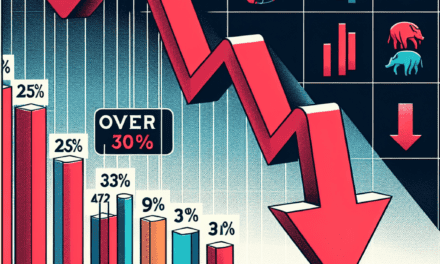“Street Talk: Coach’s Bold Buyback – Owning the Future, One Share at a Time”
Introduction
Street Talk: Coach Owner’s Strategic Move to Buy Back Its Own Shares
In a bold financial maneuver, the parent company of the iconic luxury brand Coach has announced a strategic decision to repurchase a significant portion of its own shares. This move, often seen as a vote of confidence in the company’s future prospects, is designed to enhance shareholder value and optimize capital structure. By reducing the number of shares outstanding, the company aims to increase earnings per share and potentially boost its stock price, signaling to investors that it believes its shares are currently undervalued. This buyback initiative reflects the company’s robust financial health and its commitment to delivering long-term value to its shareholders, while also reinforcing its market position amidst a competitive luxury goods landscape.
Understanding Share Buybacks: A Strategic Move by Coach Owner
In the ever-evolving landscape of the fashion industry, strategic financial maneuvers often play a pivotal role in shaping a company’s future. Recently, the owner of Coach, a renowned name in luxury fashion, has made headlines with its decision to repurchase its own shares. This move, while not uncommon in the corporate world, warrants a closer examination to understand its implications and the strategic thinking behind it.
Share buybacks, also known as share repurchases, occur when a company buys back its own shares from the marketplace. This action reduces the number of outstanding shares, often leading to an increase in the value of remaining shares. For the owner of Coach, this decision is likely driven by several key factors. Firstly, it signals confidence in the company’s financial health and future prospects. By investing in its own shares, the company is essentially betting on its continued success and growth, which can reassure investors and potentially attract new ones.
Moreover, share buybacks can be a strategic tool for optimizing capital structure. In periods of excess cash flow, companies may choose to return value to shareholders through buybacks rather than dividends. This approach can be particularly appealing in a low-interest-rate environment, where the cost of borrowing is minimal. For Coach’s owner, this move could be a way to efficiently allocate capital while simultaneously enhancing shareholder value.
Another critical aspect of share buybacks is their impact on earnings per share (EPS). By reducing the number of shares outstanding, buybacks can lead to an increase in EPS, even if net income remains constant. This can make the company appear more profitable on a per-share basis, potentially boosting its stock price. For investors, this can be an attractive proposition, as it suggests a more lucrative return on their investment.
Furthermore, share buybacks can serve as a defensive strategy against potential takeovers. By reducing the number of shares available on the open market, the company can make it more challenging for an outside entity to acquire a controlling stake. This aspect of buybacks can be particularly relevant in industries like fashion, where brand identity and control are paramount.
However, it is essential to consider the potential downsides of share buybacks. Critics argue that they can sometimes be used to artificially inflate stock prices, benefiting executives with stock-based compensation at the expense of long-term company health. Additionally, if a company overextends itself financially to fund buybacks, it may face liquidity issues in the future. Therefore, it is crucial for companies to balance buybacks with other financial obligations and growth initiatives.
In conclusion, the decision by Coach’s owner to repurchase its own shares is a multifaceted strategic move. It reflects confidence in the company’s future, optimizes capital structure, and enhances shareholder value. While there are potential risks associated with buybacks, when executed judiciously, they can be a powerful tool in a company’s financial strategy. As the fashion industry continues to navigate a complex and competitive landscape, such strategic decisions will likely play a significant role in determining which companies thrive and which falter.
Financial Implications of Coach Owner’s Share Repurchase
In recent financial news, the strategic decision by Tapestry Inc., the parent company of Coach, to repurchase its own shares has garnered significant attention. This move, often seen as a signal of confidence in the company’s future prospects, carries a multitude of financial implications that merit closer examination. By delving into the rationale behind this decision, one can better understand the potential impacts on the company’s financial health and shareholder value.
To begin with, share repurchases are typically undertaken by companies that believe their stock is undervalued. By buying back shares, Tapestry Inc. aims to reduce the number of shares outstanding, thereby increasing the earnings per share (EPS) and, consequently, the stock’s market value. This maneuver can be particularly appealing to investors, as it suggests that the company is optimistic about its future earnings potential and is committed to enhancing shareholder returns. Moreover, a share repurchase can be a more flexible way of returning capital to shareholders compared to dividends, as it does not commit the company to ongoing payments.
Furthermore, the decision to repurchase shares can also be interpreted as a strategic move to optimize the company’s capital structure. By utilizing excess cash reserves or leveraging debt to buy back shares, Tapestry Inc. can potentially improve its return on equity (ROE). This is achieved by reducing equity while maintaining or increasing net income, thus making the company more attractive to investors who focus on ROE as a key performance metric. Additionally, in an environment of low interest rates, financing share repurchases through debt can be a cost-effective strategy, allowing the company to take advantage of favorable borrowing conditions.
However, it is important to consider the potential risks associated with share repurchases. Critics often argue that such moves can be short-sighted, prioritizing immediate stock price boosts over long-term investments in growth and innovation. If not managed prudently, repurchasing shares could deplete cash reserves that might otherwise be used for strategic acquisitions, research and development, or other initiatives that drive sustainable growth. Therefore, it is crucial for Tapestry Inc. to balance its repurchase strategy with its broader business objectives to ensure long-term success.
In addition to these considerations, the timing of the share repurchase is also a critical factor. Market conditions, such as stock price volatility and economic uncertainty, can influence the effectiveness of a buyback program. By carefully assessing these external factors, Tapestry Inc. can maximize the benefits of its repurchase strategy while minimizing potential downsides. Moreover, transparent communication with investors regarding the rationale and expected outcomes of the buyback can help manage market perceptions and maintain investor confidence.
In conclusion, Tapestry Inc.’s decision to repurchase its own shares is a multifaceted strategy with significant financial implications. While it signals confidence in the company’s future and aims to enhance shareholder value, it also requires careful consideration of potential risks and market conditions. By effectively balancing these elements, Tapestry Inc. can leverage its share repurchase program to strengthen its financial position and support its long-term strategic goals. As the company navigates this complex financial landscape, stakeholders will be keenly observing the outcomes of this strategic move.
Market Reactions to Coach Owner’s Buyback Strategy
In recent developments within the luxury fashion industry, Tapestry Inc., the parent company of Coach, has made a strategic decision to repurchase its own shares, a move that has sparked considerable interest and discussion among market analysts and investors alike. This buyback strategy, often seen as a signal of confidence from a company in its own financial health and future prospects, is being closely scrutinized for its potential impact on the market and the company’s valuation.
The decision to initiate a share buyback program is typically driven by several factors, including the desire to return capital to shareholders, improve financial ratios, and signal to the market that the company’s stock is undervalued. In the case of Tapestry, the buyback is perceived as a strategic maneuver to bolster shareholder value amidst a competitive and rapidly evolving retail landscape. By reducing the number of shares outstanding, Tapestry aims to increase earnings per share, thereby potentially enhancing the attractiveness of its stock to investors.
Moreover, this move comes at a time when the luxury fashion sector is experiencing a dynamic shift, with consumer preferences evolving and digital transformation reshaping traditional business models. Tapestry’s decision to buy back shares can be interpreted as a vote of confidence in its ability to navigate these changes successfully. It suggests that the company believes in its strategic initiatives, such as expanding its digital presence and enhancing customer engagement, which are crucial for sustaining growth in a challenging market environment.
Furthermore, the buyback strategy may also be seen as a response to external pressures, such as activist investors or market speculation, which can influence a company’s stock price. By repurchasing shares, Tapestry not only demonstrates its commitment to enhancing shareholder value but also potentially mitigates the impact of such pressures. This proactive approach can help stabilize the stock price and provide a buffer against market volatility, which is particularly pertinent given the current economic uncertainties.
In addition to these strategic considerations, the timing of the buyback is noteworthy. With interest rates remaining relatively low, Tapestry can finance the repurchase at a lower cost, making it a financially prudent decision. This aspect of the buyback strategy underscores the importance of timing in corporate financial decisions, as it allows the company to leverage favorable market conditions to its advantage.
As market participants digest the implications of Tapestry’s buyback strategy, the broader impact on the luxury fashion sector remains to be seen. While some analysts view the move as a positive indicator of the company’s financial health and strategic foresight, others caution that buybacks should not be seen as a panacea for underlying business challenges. It is essential for Tapestry to continue focusing on its core business operations and strategic initiatives to ensure long-term success.
In conclusion, Tapestry’s decision to repurchase its own shares is a multifaceted strategy that reflects confidence in its future prospects and a commitment to enhancing shareholder value. As the luxury fashion industry continues to evolve, the effectiveness of this buyback strategy will be closely monitored by investors and analysts, serving as a barometer for the company’s ability to adapt and thrive in a competitive market.
Long-term Benefits of Share Buybacks for Coach Owner
In recent years, the strategic decision by Coach’s parent company, Tapestry Inc., to repurchase its own shares has garnered significant attention in the financial world. This move, often seen as a signal of confidence in the company’s future prospects, is not merely a short-term tactic to boost stock prices. Instead, it reflects a deeper, long-term strategy aimed at enhancing shareholder value and solidifying the company’s market position. By delving into the long-term benefits of such share buybacks, one can better understand the rationale behind Tapestry’s decision and its potential impact on the company’s future.
To begin with, share buybacks can lead to an immediate increase in earnings per share (EPS). By reducing the number of outstanding shares, the company’s earnings are distributed over a smaller base, thereby increasing the EPS. This metric is often used by investors to gauge a company’s profitability, and an increase in EPS can make the company more attractive to potential investors. Consequently, this can lead to a rise in the stock price, benefiting existing shareholders. However, the implications of share buybacks extend beyond this immediate financial boost.
Moreover, share repurchases can be a more flexible alternative to dividends when it comes to returning capital to shareholders. While dividends represent a fixed commitment, buybacks offer the company the discretion to adjust the scale and timing of repurchases based on its financial health and market conditions. This flexibility allows Tapestry to manage its capital more efficiently, ensuring that it can invest in growth opportunities while still rewarding shareholders. Furthermore, buybacks can signal to the market that the company’s management believes its shares are undervalued, thereby instilling confidence among investors.
In addition to these financial benefits, share buybacks can also lead to improved capital structure. By using excess cash to repurchase shares, Tapestry can optimize its balance sheet, potentially reducing its cost of capital. A more efficient capital structure can enhance the company’s ability to finance future projects and acquisitions, thereby supporting long-term growth. This strategic use of capital can be particularly advantageous in a competitive industry, where maintaining a strong financial position is crucial for sustaining market leadership.
Furthermore, the decision to buy back shares can also reflect a commitment to long-term strategic goals. For Tapestry, this move aligns with its broader vision of strengthening its brand portfolio, which includes Coach, Kate Spade, and Stuart Weitzman. By focusing on core strengths and ensuring financial stability, the company can better navigate market challenges and capitalize on emerging opportunities. This strategic alignment not only benefits shareholders but also supports the company’s mission to deliver sustainable growth.
In conclusion, Tapestry’s decision to repurchase its own shares is a multifaceted strategy that offers numerous long-term benefits. From enhancing earnings per share and providing flexibility in capital management to optimizing the capital structure and reinforcing strategic goals, share buybacks serve as a powerful tool for driving shareholder value. As Tapestry continues to execute this strategy, it positions itself to thrive in an ever-evolving market landscape, ensuring that it remains a formidable player in the luxury fashion industry. Through these strategic moves, Tapestry demonstrates its commitment to long-term success, benefiting both the company and its shareholders.
Analyzing the Timing of Coach Owner’s Share Repurchase
In the ever-evolving landscape of the luxury fashion industry, strategic financial maneuvers often serve as a barometer for a company’s confidence in its future prospects. Recently, the decision by Tapestry Inc., the parent company of Coach, to repurchase its own shares has captured the attention of market analysts and investors alike. This move, while not uncommon in the corporate world, raises intriguing questions about the timing and underlying motivations that prompted such a decision.
To begin with, share repurchases are typically viewed as a signal of a company’s belief in its intrinsic value. By buying back its own shares, a company effectively reduces the number of outstanding shares, thereby increasing the value of remaining shares. This can be particularly appealing to shareholders, as it often leads to an increase in earnings per share (EPS) and, consequently, a potential rise in stock price. In the case of Tapestry, the decision to initiate a share buyback program suggests a strong confidence in its financial health and future growth trajectory.
Moreover, the timing of this repurchase is noteworthy. The luxury fashion sector has been navigating a complex landscape marked by shifting consumer preferences, economic uncertainties, and the ongoing impact of global events such as the COVID-19 pandemic. Despite these challenges, Tapestry has demonstrated resilience, with its brands, including Coach, Kate Spade, and Stuart Weitzman, maintaining a strong market presence. The decision to repurchase shares at this juncture may indicate that Tapestry’s leadership perceives the company’s stock as undervalued, presenting an opportune moment to invest in its own future.
Furthermore, this strategic move can also be interpreted as a response to external market conditions. With interest rates remaining relatively low, companies have greater access to capital, making share repurchases a more attractive option. Additionally, the luxury sector has witnessed a resurgence in demand, particularly in key markets such as China and the United States. By capitalizing on these favorable conditions, Tapestry aims to reinforce its market position and deliver enhanced value to its shareholders.
In addition to financial considerations, the share repurchase may also reflect Tapestry’s commitment to its long-term strategic goals. The company has been actively pursuing initiatives to strengthen its digital capabilities, expand its global footprint, and enhance its sustainability efforts. By investing in its own shares, Tapestry is signaling its dedication to these objectives, while also providing a vote of confidence in its ability to execute its strategic vision.
It is also important to consider the potential impact of this decision on investor sentiment. Share repurchases are often perceived positively by the market, as they suggest that a company is generating sufficient cash flow to support such initiatives. This can lead to increased investor confidence and potentially attract new investors seeking to capitalize on the company’s growth prospects. For Tapestry, this move may serve to bolster its reputation as a stable and forward-thinking entity within the luxury fashion industry.
In conclusion, Tapestry Inc.’s decision to repurchase its own shares is a multifaceted strategic move that reflects both confidence in its current performance and optimism for its future. By carefully analyzing the timing and motivations behind this decision, it becomes evident that Tapestry is positioning itself to navigate the complexities of the luxury fashion market while delivering value to its shareholders. As the company continues to execute its strategic initiatives, the share repurchase serves as a testament to its commitment to long-term growth and success.
Impact of Share Buybacks on Coach Owner’s Stock Value
In recent years, the strategic decision by companies to repurchase their own shares has become a prevalent practice, often sparking discussions about its impact on stock value. The Coach owner’s recent move to buy back its own shares is a prime example of this trend, reflecting a calculated approach to enhance shareholder value and signal confidence in the company’s future prospects. This decision, while not uncommon, carries significant implications for the stock’s market performance and investor perception.
To begin with, share buybacks are typically employed by companies as a means to return capital to shareholders, often when they believe their stock is undervalued. By reducing the number of shares outstanding, buybacks can increase earnings per share (EPS), thereby potentially boosting the stock’s market price. In the case of Coach’s parent company, this strategic move suggests a belief that the current market price does not fully reflect the intrinsic value of the company. Consequently, the buyback can be interpreted as a positive signal to the market, indicating management’s confidence in the company’s financial health and growth trajectory.
Moreover, the impact of share buybacks on stock value is multifaceted. On one hand, the reduction in share supply can lead to an increase in demand, thereby driving up the stock price. This is particularly beneficial for existing shareholders, as it can lead to capital gains and an enhanced return on investment. On the other hand, buybacks can also improve key financial metrics, such as return on equity (ROE) and EPS, which are closely monitored by investors and analysts. These improved metrics can further bolster investor confidence and attract new investment, creating a positive feedback loop that supports the stock’s upward momentum.
However, it is important to consider the potential downsides of share buybacks. Critics often argue that buybacks can be a short-term strategy that diverts funds away from potentially more productive uses, such as research and development or capital expenditures. In the case of Coach’s owner, the decision to repurchase shares must be weighed against the opportunity cost of not investing in other areas that could drive long-term growth. Additionally, if the buyback is financed through debt, it could increase the company’s financial leverage, potentially impacting its credit rating and financial stability.
Despite these concerns, the market’s initial reaction to Coach’s share buyback announcement has been largely positive. Investors appear to view the move as a prudent allocation of capital, particularly in an environment where organic growth opportunities may be limited. Furthermore, the buyback aligns with broader market trends, where companies are increasingly prioritizing shareholder returns through dividends and repurchases.
In conclusion, the Coach owner’s strategic decision to buy back its own shares is a calculated move that underscores management’s confidence in the company’s value proposition. While the immediate impact on stock value is likely to be positive, it is essential for investors to consider the long-term implications of this strategy. As the company navigates the complexities of the retail landscape, the effectiveness of the buyback in enhancing shareholder value will ultimately depend on its ability to balance short-term gains with sustainable growth initiatives. Through careful analysis and strategic foresight, the Coach owner aims to leverage this buyback as a tool to strengthen its market position and deliver lasting value to its shareholders.
Comparing Coach Owner’s Buyback Strategy with Industry Trends
In recent years, the luxury fashion industry has witnessed a series of strategic maneuvers by major players aiming to consolidate their market positions and enhance shareholder value. Among these, the decision by Tapestry Inc., the parent company of Coach, to repurchase its own shares stands out as a noteworthy development. This move not only reflects the company’s confidence in its long-term growth prospects but also aligns with broader industry trends where companies are increasingly leveraging buybacks as a tool to optimize capital allocation.
Share buybacks have become a prevalent strategy among corporations seeking to return excess capital to shareholders. By reducing the number of shares outstanding, buybacks can enhance earnings per share (EPS) and potentially boost stock prices, thereby delivering immediate value to shareholders. Tapestry’s decision to engage in this practice underscores its commitment to maximizing shareholder returns while signaling its belief in the intrinsic value of its stock. This approach is particularly significant in the luxury sector, where brand strength and market positioning are critical to sustaining competitive advantage.
Comparatively, Tapestry’s buyback strategy mirrors similar actions taken by other luxury brands, such as LVMH and Kering, which have also utilized share repurchases as a means to bolster investor confidence and support stock valuations. These companies, like Tapestry, operate in a highly competitive environment where maintaining brand prestige and customer loyalty is paramount. By repurchasing shares, they not only demonstrate financial robustness but also convey a message of stability and resilience to the market.
Moreover, Tapestry’s buyback initiative can be seen as a response to the evolving dynamics of the luxury market, which has been characterized by fluctuating consumer preferences and economic uncertainties. In such a context, buybacks offer a flexible mechanism for companies to manage their capital structures effectively. They provide a buffer against market volatility and allow firms to adjust their financial strategies in line with changing market conditions. This adaptability is crucial for luxury brands that must navigate the delicate balance between exclusivity and accessibility.
In addition to aligning with industry trends, Tapestry’s buyback strategy reflects a broader shift towards shareholder-centric governance models. As investors increasingly demand transparency and accountability, companies are under pressure to demonstrate prudent financial management and a clear focus on shareholder value creation. By opting for share repurchases, Tapestry is not only addressing these expectations but also reinforcing its commitment to delivering sustainable growth and profitability.
Furthermore, the strategic timing of Tapestry’s buyback initiative is noteworthy. With the global economy gradually recovering from the disruptions caused by the COVID-19 pandemic, the luxury sector is poised for a resurgence in demand. By capitalizing on this anticipated recovery, Tapestry aims to position itself advantageously within the market, ensuring that it remains competitive and well-equipped to capture emerging opportunities.
In conclusion, Tapestry’s decision to buy back its own shares is a strategic move that aligns with prevailing industry trends and reflects the company’s confidence in its future prospects. By leveraging share repurchases, Tapestry not only enhances shareholder value but also strengthens its market position in a rapidly evolving luxury landscape. As the industry continues to navigate challenges and opportunities, such strategic initiatives will likely play a pivotal role in shaping the competitive dynamics of the luxury fashion sector.
Q&A
1. **What is Street Talk?**
Street Talk is a company known for its innovative approach in the retail or service industry, often focusing on urban and contemporary markets.
2. **Who is the Coach Owner?**
The Coach Owner refers to the parent company or major stakeholder of the Coach brand, which is a luxury fashion company known for its leather goods and accessories.
3. **What is the strategic move being discussed?**
The strategic move involves the Coach Owner deciding to buy back its own shares from the market.
4. **Why would a company buy back its own shares?**
Companies buy back shares to reduce the number of shares available in the market, which can increase the value of remaining shares, improve financial ratios, and signal confidence in the company’s future prospects.
5. **How does a share buyback affect shareholders?**
A share buyback can benefit shareholders by potentially increasing the value of their shares and providing a return of capital if the company pays a premium for the shares.
6. **What are potential risks of a share buyback?**
Risks include the possibility of misallocating capital, reducing cash reserves needed for other investments, and the buyback not leading to the desired increase in share value.
7. **What impact could this move have on the market perception of Street Talk?**
The buyback could improve market perception by demonstrating confidence in the company’s financial health and future growth prospects, potentially attracting more investors.
Conclusion
The strategic move by Coach’s owner to buy back its own shares can be seen as a vote of confidence in the company’s future prospects and financial health. By repurchasing shares, the company potentially increases the value of remaining shares, signaling to investors that it believes its stock is undervalued. This action can also improve financial metrics such as earnings per share, making the company more attractive to investors. Additionally, it may indicate that the company has excess cash and limited opportunities for high-return investments, prompting it to return value to shareholders through buybacks. Overall, this move could strengthen investor confidence and stabilize the company’s stock price in the market.





